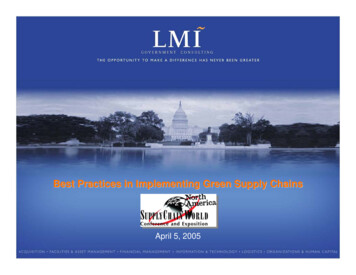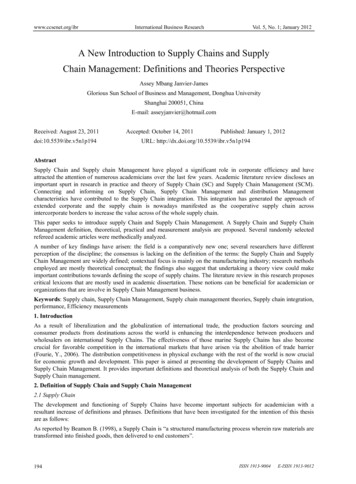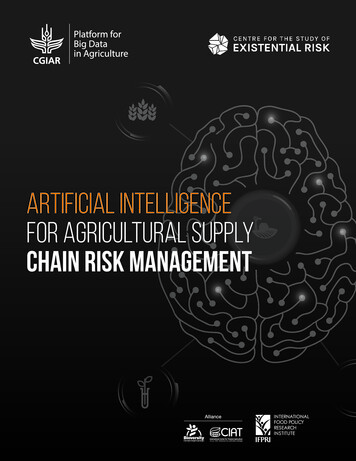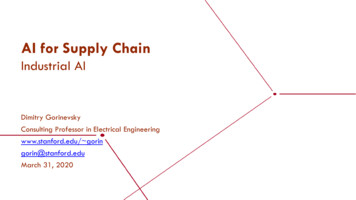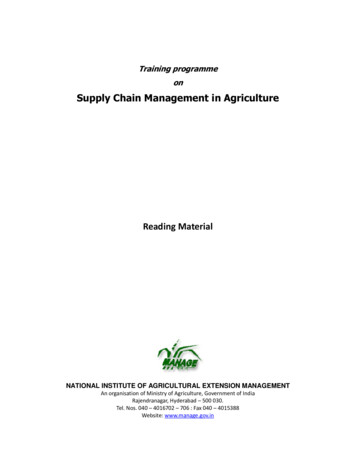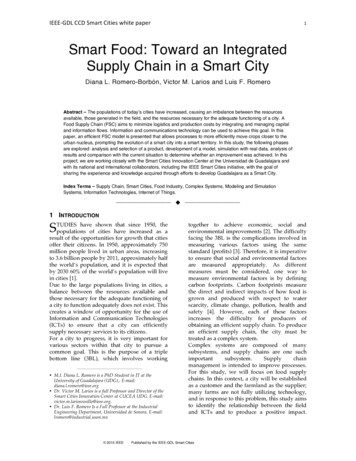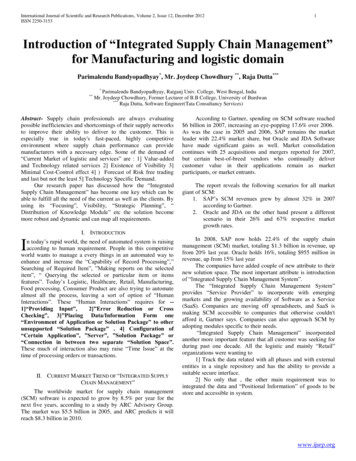
Transcription
International Journal of Scientific and Research Publications, Volume 2, Issue 12, December 2012ISSN 2250-31531Introduction of “Integrated Supply Chain Management”for Manufacturing and logistic domainParimalendu Bandyopadhyay*, Mr. Joydeep Chowdhury **, Raja Dutta******Parimalendu Bandyopadhyay, Raiganj Univ. College, West Bengal, IndiaMr. Joydeep Chowdhury, Former Lecturer of B.B College, University of Burdwan***Raja Dutta, Software Engineer(Tata Consultancy Services)Abstract- Supply chain professionals are always evaluatingpossible inefficiencies and shortcomings of their supply networksto improve their ability to deliver to the customer. This isespecially true in today's fast-paced, highly competitiveenvironment where supply chain performance can providemanufacturers with a necessary edge. Some of the demand of“Current Market of logistic and services” are : 1] Value-addedand Technology related services 2] Existence of Visibility 3]Minimal Cost-Control effect 4] ) Forecast of Risk free tradingand last but not the least 5] Technology Specific Demand.Our research paper has discussed how the “IntegratedSupply Chain Management” has become one key which can beable to fulfill all the need of the current as well as the clients. Byusing its “Focusing”, Visibility, “Strategic Planning”, “Distribution of Knowledge Module” etc the solution becomemore robust and dynamic and can map all requirements.According to Gartner, spending on SCM software reached 6 billion in 2007, increasing an eye-popping 17.6% over 2006.As was the case in 2005 and 2006, SAP remains the marketleader with 22.4% market share, but Oracle and JDA Softwarehave made significant gains as well. Market consolidationcontinues with 25 acquisitions and mergers reported for 2007,but certain best-of-breed vendors who continually delivercustomer value in their applications remain as marketparticipants, or market entrants.The report reveals the following scenarios for all marketgiant of SCM:1. SAP’s SCM revenues grew by almost 32% in 2007according to Gartner.2. Oracle and JDA on the other hand present a differentscenario in their 26% and 67% respective marketgrowth rates.I. INTRODUCTIONn today’s rapid world, the need of automated system is raisingaccording to human requirement. People in this competitiveworld wants to manage a every things in an automated way toenhance and increase the “Capability of Record Processing”,”Searching of Required Item”, ”Making reports on the selecteditem”, “ Querying the selected or particular item or itemsfeatures”. Today’s Logistic, Healthcare, Retail, Manufacturing,Food processing, Consumer Product are also trying to automatealmost all the process, leaving a sort of option of “HumanInteractions”. These “Human Interactions” requires for -1]“Providing Input”,2]”Error Reduction or CrossChecking”, 3]”Placing Data/Information Form one“Environment of Application or Solution Package” to otherunsupported “Solution Package” . 4] Configuration of“Certain Application”, ”Server”, ”Solution Package” or“Connection in between two separate “Solution Space”.These much of interaction also may raise “Time Issue” at thetime of processing orders or transactions.III. CURRENT MARKET TREND OF “INTEGRATED SUPPLYCHAIN MANAGEMENT”The worldwide market for supply chain management(SCM) software is expected to grow by 8.5% per year for thenext five years, according to a study by ARC Advisory Group.The market was 5.5 billion in 2005, and ARC predicts it willreach 8.3 billion in 2010.In 2008, SAP now holds 22.4% of the supply chainmanagement (SCM) market, totaling 1.3 billion in revenue, upfrom 20% last year. Oracle holds 16%, totaling 955 million inrevenue, up from 15% last yearThe companies have added couple of new attribute to theirnew solution space. The most important attribute is introductionof “Integrated Supply Chain Management System”.The “Integrated Supply Chain Management System”provides “Service Provider” to incorporate with emergingmarkets and the growing availability of Software as a Service(SaaS). Companies are moving off spreadsheets, and SaaS ismaking SCM accessible to companies that otherwise couldn'tafford it, Gartner says. Companies can also approach SCM byadopting modules specific to their needs.“Integrated Supply Chain Management” incorporatedanother more important feature that all customer was seeking forduring past one decade. All the logistic and mainly “Retail”organizations were wanting to1] Track the data related with all phases and with externalentities in a single repository and has the ability to provide asuitable secure interface.2] No only that , the other main requirement was tointegrated the data and “Positional Information” of goods to bestore and accessible in system.www.ijsrp.org
International Journal of Scientific and Research Publications, Volume 2, Issue 12, December 2012ISSN 2250-3153III. WHY CUSTOMER LIKE “INTEGRATED SUPPLY CHAINMANAGEMENT”The “Integrated SCM” include the enhancements fortracking shelf life data related to consumer products, contractmanufacturing for the high tech industry, and campaign planningfor chemical and processing industries. They also addedtransportation management that addresses shipper and complexcarrier requirements.The focus has been on increasing network visibility andimproved collaboration and planning across the businessnetwork. This collaboration across end to end business processesthat span traditional company, department and softwareboundaries are now being demanded by customers.The other new feature that made “Integrated Supply ChainManagement” more likeable solution for the customer are asfollows: Closer collaboration with business partners toimprove visibilityo Enhancedcapabilitiesforoutsourcedmanufacturing in SNC to improve supplynetworkinventoryandworkordercollaboration.o Functionality for supplier collaboration enablessuppliers to create Web-based invoices, leadingto quicker response times for improved productturnaround.o Enhanced replenishment collaboration (vendormanaged inventory) with new and broadercapabilities and a unique menu approachdisplayable in various levels of detail,depending on the supplier’s needs. Maximized workforce planning to increaseproductivityo Enhanced labor management functionality tomaximize the productivity of the warehouseworkforce with out-of-the-box reporting,designed for direct and indirect labor. Enhanced planning to improve efficiencyo Enhancements to advanced planning andoptimization, mainly in supply networkplanning as well as production planning anddetailed scheduling to help businesses createnew innovative planning scenarios thatoptimize capacity utilization and help ensuretimely delivery.o New features such as capacity reservationshelp shorten delivery times to strategiccustomers. Integrate enterprise service-oriented architecture(enterprise SOA) with “Integrated SCM: Integratethe functionalities of SOA with the new release will bedelivered as services, enabling customers to deploy andadapt solutions specifically to their individual businessneeds. Customers will be able to, for example, deployfunctionalities such as supply network collaboration andextended warehouse management without installing anddeploying the complete SCM solution. This delivery 2approach will enable rapid deployment and faster returnon investment.Increased customer satisfaction – It offers a commoninformation framework that supports communicationand collaboration, Integrated SCM enables you to betteradapt to and meet customer demands.Compliance with regulatory requirements –Organization can track and monitor compliance in areassuch as environment, health, and safety with “IntegratedSCM”.Improved cash flow – Information transparency andreal-time business intelligence can lead to shorter cashto-cash cycle times. Reduced inventory levels andincreased inventory turns across the network can loweroverall costs.Higher margins – With Integrated SCM, company canlower operational expenses with more timely planningfor procurement, manufacturing, and transportation.Better order, product, and execution tracking can lead toimprovements in performance and quality – and lowercosts. Organization can also improve margins throughbetter coordination with business partners.Greater synchronization with business priorities –Tight connections with trading partners keep supplychain aligned with current business strategies andpriorities, improving your organization's overallperformance and achievement of goals.IV. A CURRENT “SURVEY” ON INTEGRATED SUPPLY CHAINMANAGEMENT A survey involving 259 manufacturing firms fromvarious industries in the United States and Europeidentified the following supply chain initiatives thatorganizations intended to implement over the next twoyears: The following table is describing the investmentplan of organization in “Integrated Supply gimprovements SystemCustomer service improvement SystemNetwork optimization and arehouse Facility ManagementOrder processing SystemStrategic SystemConsolidation of facilities managementPercentage1823147912134www.ijsrp.org
International Journal of Scientific and Research Publications, Volume 2, Issue 12, December 2012ISSN 2250-3153Current Survey on Customer Likings on “Integrated SupplyChain Management”:Integrated “Supply Chain Management” has occupied allmost a major revenue sectors for the logistic and in retailindustries. There is a growing number of customer who believeson the integration of supply chain management with the othermodules called “ERP”, ”Ware house management”, ”LaborManagement”, ”Transport Management” etc.The total number of customer those who are involved ofusing “Supply Chain Management” are about more than a lack.Among them now approximately 40,000 of customer directlyrelated with the services of either “Integrated Supply ChainManagement” or at least using most of the modules of“Integrated Supply Chain Management”. Among them some ofthe names are BMW, Colgate-Palmolive, Hindustan Unilever,3Novelis Switzerland, Robert Bosch, Sentipharm, Siemens PowerGeneration etc. Table below is providing the number of customerof “Integrated Supply Chain Management” have:SolutionProviderSAPOracleSwiss LogManhattanAssociateNo. of Supply ChainCustomer(Approx) in200914,50010,00030005000No. of Supply ChainCustomer(Approx)in 200920,30017,000No Data availableNo Data availableNumber of customer for each “Integrated Supply Chain Solution” provider. Below in chartV. INTEGRATED SUPPLY CHAIN MARKET IN EUROPEThe “Integrated Supply Chain Market” has brought a bigrevolution in customer centric environment. It is giving customera bunch of solution in a affordable price. Even it is also offeringcustomer all the option to choose the required module for thesolution. The “Integrated Supply Chain Concept” first born inEurope and spread across the world. It has a environmentindependent functional ability to work on any platform. Thefollowing table shows the revenue has earned by “IntegratedSupply Chain Solution provider in 2005-2009 in Europe. Therevenue in 2010 was around 1200 million USD which is around3% from 2009. In 2012, this revenue is expected to be 1400million USD around.YearTurn over in Million 020121400www.ijsrp.org
International Journal of Scientific and Research Publications, Volume 2, Issue 12, December 2012ISSN 2250-31534Table and graph above represent the revenue earned by “Integrated SupplyChain Solution provider in world in 2001-2011www.ijsrp.org
International Journal of Scientific and Research Publications, Volume 2, Issue 12, December 2012ISSN 2250-3153VI. INTEGRATED SUPPLY CHAIN MARKET IN ALL OVER THEWORLDThe “Supply Chain Market” in world was 4.5 billion USDas per growth, which increased about 5.2 billion USD about0.23% The growth up to 2006 was 7.7, 9, 9.93, 11.87 billion5USD respectively. The growth rate was nearly vary from 0.30.85%. But in late 2006 the concept of “Integrated Supply ChainManagement” has evolved and the growth rate jump from 13 to15 billion USD ; growth jump 1.5%. Where in 2011, the growthrate become bit slow and came to 17.3 billion USD rated 3.8%.YearTurn over in Billion 13.2200815201117.3VII. RESEARCH METHODOLOGYWe have work with the sales team in major IT providers inIndia. Here we come to know why IT industries are interested toimplement “Integrated Supply Chain Management” to face theglobal changes in service providing areas and compete with otherfirms. How the IT/ITES industries are mapping them with thechanging happening through “Integrated Supply ChainManagement”.During this period we also came to know what process areuse to ““Integrate the Supply Chain Management” and whattools are being used. What are the phases of “Integrated SupplyChain Management, How it can be implemented in a project etc.Here we come to know what are the new phases that mostof the organizations are implementing depending on eithercapability, verticals or economical condition. How a company iswww.ijsrp.org
International Journal of Scientific and Research Publications, Volume 2, Issue 12, December 2012ISSN 2250-3153measuring the require changes after implementation of“Integrated Supply Chain Management”? What are theadvantages of “Integrated Supply Chain Management”? How thenew technology and approach will help to implement “IntegratedSupply Chain Management” in Business.VIII. CONCLUSIONFuture supply chains are likely to be more dynamic innature, and consist of collaborative value networks in whichproductivity and efficiency are constantly maximized.Purchasing firms need to ensure that costs and risks are equitablyshared across the supply chain. Risk management has become astrategic imperative – particularly for manufacturers operatingglobal supply chains.The main goal of this research is to make understandpeople how the “Integrated Supply Chain Management System”used to work and why customer like it to integrated with theirentire company based solution. Here are some focuses on“Integrated /supply Chain Management”.The first liking of the customer is its “Risk Reduction”wings which can take input from any of the data repositories in asystem with making interface with any kind of application,irrespective of Web or Console or stand alone applications etc.Second most liking of customer its “Strategic AdvantageProviding Module” and “Planning & Forecasting Module” whichhelps us to implement a strategic partnership with client andvendor. Helps to make a full utilized plan module along withforecasting system. The “Decision Making System” plays here abig role.The third and fore most important feature all the modulesare integrated and able to incorporate with any other solutionshence it is more cost effective and “Client Centric SolutionOriented”.Advancements in IT have significantly improved SCM butthere continues to be enormous potential for furtherdevelopment. The business world most likely shifting from “Traditional Supply Chain management” to “Value Added SupplyChain Management” and the day is not so far where the“Integrated Supply Chain Management” will replace the“Traditional Supply Chain Management” with more scope andenhanced solution and with “Value added Services.IX. RESEARCH METHODOLOGYWe have work with the sales team in major IT providers inIndia. Here we come to know why IT industries are interested toimplement “Integrated Supply Chain Management” to face theglobal changes in service providing areas and compete with otherfirms. How the IT/ITES industries are mapping them with thechanging happening through “Integrated Supply ChainManagement”.During this period we also came to know what process areuse to ““Integrate the Supply Chain Management” and whattools are being used. What are the phases of “Integrated SupplyChain Management, How it can be implemented in a project etc.6Here we come to know what are the new phases that most of theorganizations are implementing depending on either capability,verticals or economic condition. How a company is measuringthe require changes after implementation of “Integrated SupplyChain Management”? What are the advantages of “IntegratedSupply Chain Management”? How the new technology andapproach will help to implement “Integrated Supply ChainManagement” in Business.X. LITERATURE REVIEWDr Parimalendu Bandhyapadhya, Joydeep Chowdhuryexamined various aspects of the currently running “Supply ChainManagement”system for the logistic and manufacturingcompanies. The outcome of the research is this re currentlyrunning system needs to be integrated with other “Line ofBusiness” system to capture the changing aspects oforganization, market and demand & supply. It can leads to easymonitoring to for higher management of current market scenariosand stock. It not only provide better solutions towards the growthand better manage of item stock, but also helps to manage the “Back office from font proceeding units” in short “the store can bemanageable from remote”. The other valuable point is the systemnot only provides the better analytical result for today butprovides the future aspects of organization and helpsmanagement to make decision according to that.REFERENCES[1][2][3][4][5][6]Pålsson, H., & Johansson, O. (2009). Supply chain integration obtainedthrough uniquely labelled goods: A survey of Swedish manufacturingindustries International Journal of Physical Distribution & LogisticsManagement, 39 (1), 28-46 DOI: 10.1108/09600030910929174Christopher, M., & Lee, H. (2004). Mitigating supply chain risk throughimproved confidence International Journal of Physical Distribution &Logistics Management, 34 (5), 388-396 DOI: 10.1108/09600030410545436Hanafi, J., Kara, S., & Kaebernick, H. (2008). Reverse logistics strategiesfor end-of-life products The International Journal of LogisticsManagement, 19 (3), 367-388 DOI: 10.1108/09574090810919206Masson, R., Iosif, L., MacKerron, G., & Fernie, J. (2007). Managingcomplexity in agile global fashion industry supply chains The InternationalJournal of Logistics Management, 18 (2), 238-254 DOI:10.1108/09574090710816959Cho, J., Ozment, J., & Sink, H. (2008). Logistics capability, logisticsoutsourcing and firm performance in an e-commerce market InternationalJournal of Physical Distribution & Logistics Management, 38 (5), 336-359DOI: 10.1108/09600030810882825Spekman, R., & II, P. (2006). RFID: from concept to implementationInternational Journal of Physical Distribution & Logistics Management, 36(10), 736-754 DOI: 10.1108/09600030610714571AUTHORSFirst Author – Parimalendu Bandyopadhya, Assistant Professor,Raiganj Univ. College West Bengal, India, EmailID:email2pari@rediffmail.com, Contact Number: 9434114317Second Author – Mr. Joydeep Chowdhury, Former Lecturer ofB.B College, University of BurdwanThird Author – Raja Dutta, Software Engineer(TataConsultancy Services)www.ijsrp.org
International Journal of Scientific and Research Publications, Volume 2, Issue 12, December 2012ISSN 2250-31537www.ijsrp.org
using "Supply Chain Management" are about more than a lack. Among them now approximately 40,000 of customer directly related with the services of either "Integrated Supply Chain Management" or at least using most of the modules of "Integrated Supply Chain Management". Among them some of the names are BMW, Colgate-Palmolive .





